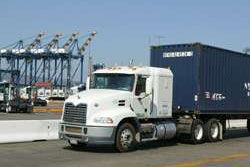
The National Highway Traffic Safety Administration on Thursday, Dec. 8, announced updated 2010 fatality and injury data showing that highway deaths fell to 32,885 for the year, the lowest level since 1949. The record-breaking decline in traffic fatalities occurred even as American drivers traveled nearly 46 billion more miles during the year, an increase of 1.6 percent over the 2009 level.
The latest numbers also revealed that fatalities rose among large truck occupants, and the American Trucking Associations urged policymakers to avoid jumping to conclusions based on the data. Truck-related fatalities rose 8.7 percent in 2010, the first increase since 2005, and 3,675 people died in truck-related accidents in 2010, an increase of 295 over the 2009 figure of 3,380, ending a three-year decline.
“While we have more work to do to continue to protect American motorists, these numbers show we’re making historic progress when it comes to improving safety on our nation’s roadways,” says U.S. Transportation Secretary Ray LaHood. “Thanks to the tireless work of our safety agencies and partner organizations over the past few decades, to save lives and reduce injuries, we’re saving lives, reducing injuries and building the foundation for what we hope will be even greater success in the future.”
The updated information released by NHTSA indicates 2010 also saw the lowest fatality rate ever recorded, with 1.10 deaths per 100 million vehicle miles traveled in 2010, down from 1.15 deaths per 100 million vehicle miles traveled in 2009. Among other key statistics:
• Fatalities declined in most categories in 2010, including for occupants of passenger cars and light trucks (including SUVs, minivans and pickups);
• Deaths in crashes involving drunk drivers dropped 4.9 percent in 2010, taking 10,228 lives compared to 10,759 in 2009; and
• Fatalities rose among pedestrians, motorcycle riders and large truck occupants.
“Every fatality on our highways is a tragedy, and the uptick in the 2010 preliminary report concerns us deeply,” said Bill Graves, ATA president and chief executive officer. “Without more information and analysis, though, it is difficult to draw conclusions about what this preliminary data means. We would hope that policymakers will avoid the ‘error of recency’ by overemphasizing the newest data at the expense of the overall long-term trend, which has been overwhelmingly positive. We look forward to seeing further analysis from DOT on crash types as well as how many miles American motorists and truck drivers traveled last year.”
Graves said that 2010 was the among the safest years on record for the trucking industry “thanks in large part to the good faith efforts of America’s truck drivers, vehicle manufacturers, truck fleet safety directors, law enforcement officers and true safety advocates, rather than due to economic hardship or other ancillary factors. By remaining vigilant and focused on the true causes of crashes, I’m confident that we will be able to continue the marked declines in the number of truck-involved crashes and fatalities on our highways that we have seen in over the past decade.”
The full and complete data from DOT for the last decade shows improvement in overall highway safety, including trucking’s safety improvement. Over the past 10 years (1999-2009), the number of large trucks involved in:
• Fatal crashes dropped by 35 percent; and
• Injury crashes dropped by 48 percent.
During that period, the number of registered large trucks grew by more than 3 million, or 41 percent.
The number of passenger vehicles involved in:
• Fatal crashes dropped by 24 percent, 11 percentage points lower than the change in the truck numbers; and
• Injury crashes dropped by 29 percent, 19 percentage points lower than the change in the truck numbers.
Over the past 10 years, the number of registered passenger vehicles grew by more than 17 percent, 24 percentage points lower than the truck growth.
Over the most recent years of economic growth (2002 to 2007 – using the base recession year of 2001):
• The truck-involved fatality rate dropped by 35 percent;
• The truck-involved injury rate dropped by 47 percent;
• The passenger vehicle fatality rate dropped by 11 percent, 24 percentage points lower than the change in the truck rate; and
• The passenger vehicle injury rate dropped by 23 percent, 24 percentage points lower than the change in the truck rate.
During the recession (2008 and 2009 – using the base year of 2007):
• The truck-involved fatality rate dropped 26 percent; and
• The passenger vehicle fatality dropped 16 percent, 10 percentage points lower than the change in the truck rate.












